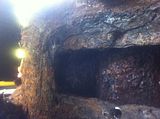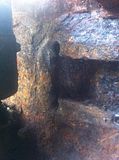The only corrosion evident on my motor is at the waterjacket cover plate and just below behind the starter.
Is she too far gone?
Removed the starter, accessory pulley and waterjacket cover. Now I know why those bolts came out so easy. The opening is all corroded.

Here she is before I cleaned her up with a rubber mallet and a screw driver.

Here she is after,

I think I need to order at least 2 of the repair kits with the backing plates. I may just put 4 in.
I was thinking that I could use the spinning wire brush followed with an angle grinder to clean her up and then rebuild with JB weld and smoothing with a sander.
It this possible? Suggestions welcome.
It appears the motor had a continuous weep (open seacock?) from this one spot on the cover.
Is she too far gone?
Removed the starter, accessory pulley and waterjacket cover. Now I know why those bolts came out so easy. The opening is all corroded.

Here she is before I cleaned her up with a rubber mallet and a screw driver.

Here she is after,

I think I need to order at least 2 of the repair kits with the backing plates. I may just put 4 in.
I was thinking that I could use the spinning wire brush followed with an angle grinder to clean her up and then rebuild with JB weld and smoothing with a sander.
It this possible? Suggestions welcome.
It appears the motor had a continuous weep (open seacock?) from this one spot on the cover.
 It seems any previous tests are null & void with significant material removed from the mating surfaces.
It seems any previous tests are null & void with significant material removed from the mating surfaces. 




Comment